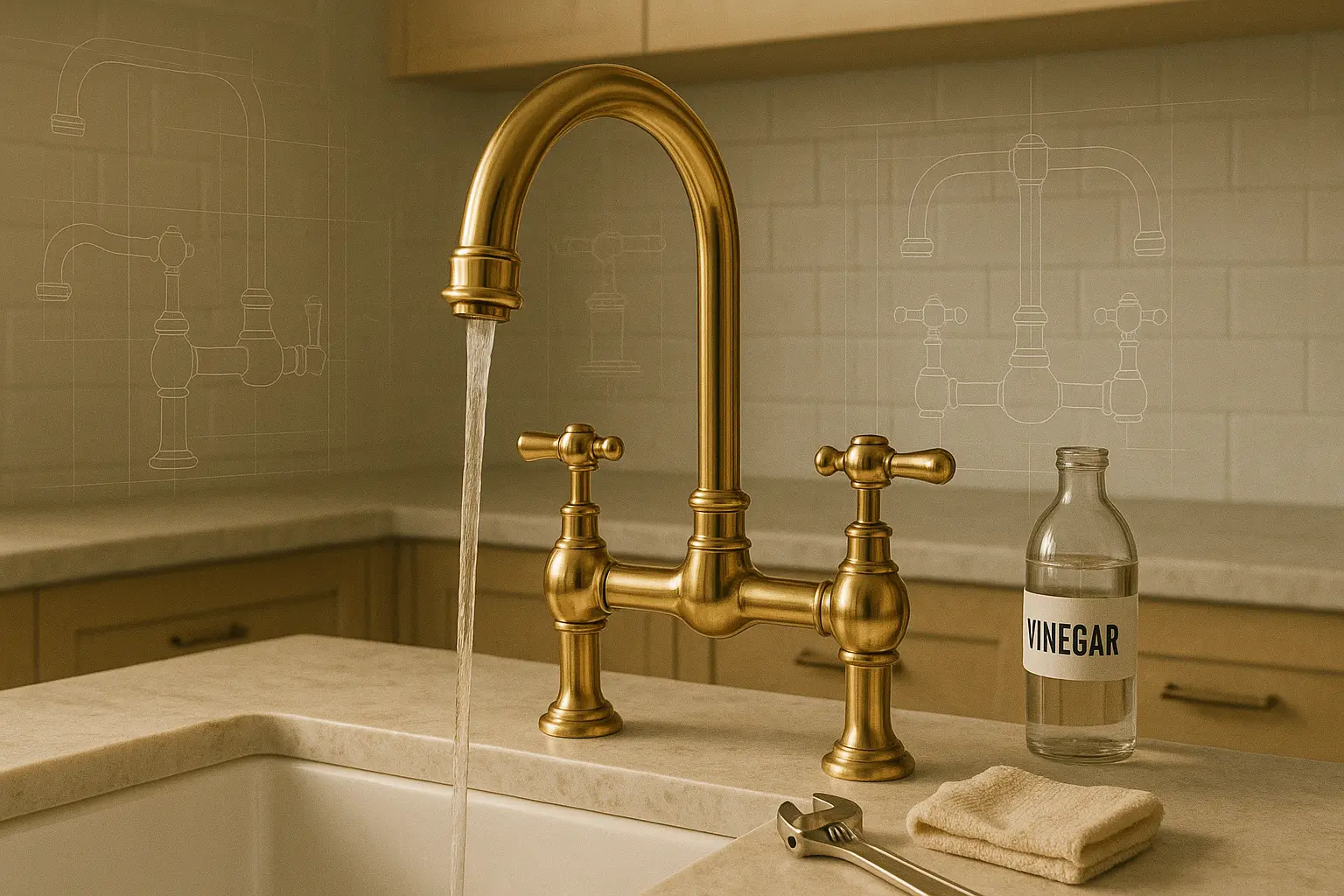
Essential Safety Features for Every Shower
Safety Features for Every Shower Shower safety is a top priority for a secure bathing environment. Falls are the leading


Even the most luxurious and well-made kitchen fixtures can experience wear and tear over time. From reduced water pressure to persistent drips, faucet problems are a common inconvenience—but the good news is, most can be prevented or easily fixed with the right know-how.
Whether you’ve invested in a high-end unlacquered brass kitchen faucet or are exploring premium bridge-style options, this guide will help you diagnose, prevent, and treat the most frequent faucet issues. Understanding the causes behind common faucet malfunctions and learning how to care for your fixture properly will not only extend its lifespan but also preserve its appearance and performance.
Faucets are exposed to constant water flow, temperature changes, and mineral buildup. Here are some of the most typical faucet problems homeowners encounter:
A leaking faucet can waste gallons of water per day and often signals a minor issue that’s easy to fix. If you’re working with a bridge faucet, consider checking out our detailed step-by-step installation guide a useful reference when disassembling or inspecting parts.
To reduce mineral buildup over time, regular cleaning is key—especially for brass kitchen faucets, which can develop limescale when not maintained.
Pro tip: Periodic maintenance can prevent stiffness from developing in the first place. Learn more about how to care for brass components with our cleaning guide for household products.
If the noise persists after these fixes, it might be time to upgrade to a better-engineered fixture. Explore our full collection of premium faucets for quiet, high-performance options.
Unlacquered brass develops a beautiful natural patina over time, but if you prefer to maintain its original shine, see our full guide on how to clean brass using household products.
Regularly check your faucet for leaks, unusual sounds, or changes in water pressure. Early detection of problems can prevent larger repairs later.
Especially for unlacquered brass kitchen faucets, routine cleaning prevents tarnish and buildup. Use natural, brass-safe products and avoid abrasive scrubs.
Hard water is a major cause of faucet wear and mineral deposits. Installing a softener helps extend the life of your faucet’s internal components.
Excessive force can damage internal washers and cause leaks. Use gentle control when adjusting water temperature and flow.
Many faucet problems originate from low-quality components. Investing in premium fixtures—like those from Insideast’s Bridge Faucet Collection ensures long-term performance and fewer issues down the line.
While fixing faucet problems as they arise is important, proactive maintenance is the true key to ensuring your faucet performs flawlessly for decades. Whether you’ve installed a traditional stainless steel fixture or a luxurious unlacquered brass kitchen faucet from Insideast, these advanced care tips will help preserve function, beauty, and value.
Even if your faucet appears spotless on the outside, internal components like cartridges, aerators, and valve seats can silently accumulate debris and limescale.
What to do:
If you’re unsure how your faucet is constructed, consult our Bridge Faucet Installation Guide for a visual reference.
If you have a brass bridge faucet—especially one that’s unlacquered—it will naturally develop a patina over time. While many homeowners appreciate this aging process, others prefer to maintain a polished look.
How to maintain shine:
For specific polishing methods, see our test-backed article: How to Clean Brass – 5 Effective and Easy Methods.
If you notice recurring faucet problems like leaking, squeaking, or reduced flow—even after cleaning—your internal parts may be wearing out. Instead of opting for generic replacements, upgrade to premium-quality cartridges, washers, and valves.
What to look for in replacement parts:
Premium internal components can transform even a budget faucet into a high-performance fixture. However, if your faucet is past its prime, consider exploring a replacement from our full kitchen faucet collection to match quality with longevity.
Many faucet issues—like water hammer, inconsistent flow, or excessive spout wear—stem from poor water pressure management.
Pro-level tip:
By optimizing water pressure and pairing it with high-quality fixtures—such as those found in our Best Bridge Faucets of 2025 you safeguard your plumbing and improve daily faucet function.
Sometimes, the best solution to ongoing faucet problems is to replace the fixture altogether—especially if:
In that case, consider upgrading to a unlacquered brass kitchen faucet or one of our expertly crafted bridge faucet models designed to last and look stunning for years.
Faucet issues are a common but manageable part of kitchen upkeep. Whether it’s a leaky handle, reduced water pressure, or tarnished brass, these problems can be treated or prevented with routine maintenance and timely intervention.
By following the tips above and choosing a high-quality fixture from Insideast’s unlacquered brass faucet collection, you’ll reduce the likelihood of common faucet problems and enjoy a kitchen that performs as beautifully as it looks.

Safety Features for Every Shower Shower safety is a top priority for a secure bathing environment. Falls are the leading
Receive your order to your door address anywhere in the world using our shipping partners
You're covered by our 30 days return policy
Big part of our reviews testifies about the quality of support provided
Secured payments using renowned payment gateways